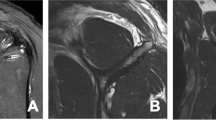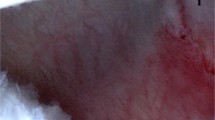Abstract
Introduction
Recurrent shoulder instability after arthroscopic Bankart repair is still a common complication. For primary Bankart repair studies have shown that the rotator cuff can recover completely. The ability of muscles to regenerate after arthroscopic revision Bankart repair (ARBR) has not been studied. Does the ARBR using a three-portal method allows complete muscle integrity compared with an uninjured imaging control group (ICG)?
Materials and methods
Twenty-two (1 female, 21 males) physically active patients (mean age at follow-up 28.5 ± 7.1 years; mean follow-up 27.5 months ± 8.5) were assessed. ARBR with a three-portal method was carried out in all patients according to previous primary arthroscopic stabilization of the shoulder (revision Bankart group). Muscle atrophy of the subscapularis muscle (SSC), supraspinatus muscle (SSP) and infraspinatus muscle (ISP) was assessed by making lateral and vertical measurements by magnetic resonance imaging (MRI). Fatty infiltration was detected by standardized assessment from variations in intensity. Detailed clinical examination of the rotator cuff was carried out. MRI assessment was compared with that of a control group of 22 healthy volunteers of same age and activity level (ICG).
Results
For the SSC, no muscle impairment was noted compared with the ICG [superior atrophy index (sAISSC), p = 0.439; inferior atrophy index (iAISSC), p = 0.555; superior fatty infiltration index (sFDISSC), p = 0.294; inferior fatty infiltration index (iFDISSC), p = 0.62]. In investigation of the SSP and ISP, fatty infiltration was not shown (FDISSP, p = 0.454; sFDIISP, p = 0.504), though persistent muscle atrophy was found even > 2 years after surgery compared with the ICG (AISSP, p = 0.0025; sAIISP, p = 0.0009; iAIISP, p = 0.0004).
Conclusion
ARBR using a three-portal method allowed good muscular integrity compared with the ICG, but with persistent slight muscular atrophy of the SSP and ISP.
Similar content being viewed by others
References
Arce G, Arcuri F, Ferro D, Pereira E (2011) Is selective arthroscopic revision beneficial for treating recurrent anterior shoulder instability? Clin Orthop Relat Res. https://doi.org/10.1007/s11999-011-2001-0
Boileau P, Richou J, Lisai A, Chuinard C, Bicknell RT (2009) The role of arthroscopy in revision of failed open anterior stabilization of the shoulder. Arthroscopy 25:1075–1084. https://doi.org/10.1016/j.arthro.2009.04.073
Boileau P, Villalba M, Hery JY, Balg F, Ahrens P, Neyton L (2006) Risk factors for recurrence of shoulder instability after arthroscopic Bankart repair. J Bone Jt Surg Am 88:1755–1763. https://doi.org/10.2106/JBJS.E.00817
Burkhart SS, Morgan CD, Kibler WB (2003) The disabled throwing shoulder: spectrum of pathology part I: pathoanatomy and biomechanics. Arthroscopy 19:404–420. https://doi.org/10.1053/jars.2003.50128
Butt U, Rashid MS, Temperley D, Crank S, Birch A, Freemont AJ, Trail IA (2016) Muscle regeneration following repair of the rotator cuff. Bone Jt J 98-B:1389–1394. https://doi.org/10.1302/0301-620X.98B10.37231
Fabbriciani C, Milano G, Demontis A, Fadda S, Ziranu F, Mulas PD (2004) Arthroscopic versus open treatment of Bankart lesion of the shoulder: a prospective randomized study. Arthroscopy 20:456–462
Franceschi F, Longo UG, Ruzzini L, Rizzello G, Maffulli N, Denaro V (2008) Arthroscopic salvage of failed arthroscopic Bankart repair: a prospective study with a minimum follow-up of 4 years. Am J Sports Med 36:1330–1336. https://doi.org/10.1177/0363546508314403
Friedman LG, Griesser MJ, Miniaci AA, Jones MH (2014) Recurrent instability after revision anterior shoulder stabilization surgery. Arthroscopy 30:372–381. https://doi.org/10.1016/j.arthro.2013.11.019
Gamulin A, Pizzolato G, Stern R, Hoffmeyer P (2002) Anterior shoulder instability: histomorphometric study of the subscapularis and deltoid muscles. Clin Orthop Relat Res 398:121–126
Gigis I, Heikenfeld R, Kapinas A, Listringhaus R, Godolias G (2014) Arthroscopic versus conservative treatment of first anterior dislocation of the shoulder in adolescents. J Pediatr Orthop 34:421–425. https://doi.org/10.1097/BPO.0000000000000108
Habermeyer P, Gleyze P, Rickert M (1999) Evolution of lesions of the labrum-ligament complex in posttraumatic anterior shoulder instability: a prospective study. J Shoulder Elbow Surg 8:66–74
Ho AG, Gowda AL, Michael Wiater J (2016) Evaluation and treatment of failed shoulder instability procedures. J Orthop Traumatol. https://doi.org/10.1007/s10195-016-0409-8
Kibler WB (1998) The role of the scapula in athletic shoulder function. Am J Sports Med 26:325–337
Kibler WB, McMullen J (2003) Scapular dyskinesis and its relation to shoulder pain. J Am Acad Orthop Surg 11:142–151
Krueger D, Kraus N, Pauly S, Chen J, Scheibel M (2011) Subjective and objective outcome after revision arthroscopic stabilization for recurrent anterior instability versus initial shoulder stabilization. Am J Sports Med 39:71–77. https://doi.org/10.1177/0363546510379336
Labriola JE, Jolly JT, McMahon PJ, Debski RE (2004) Active stability of the glenohumeral joint decreases in the apprehension position. Clin Biomech (Bristol, Avon) 19:801–809. https://doi.org/10.1016/j.clinbiomech.2004.05.008
Labriola JE, Lee TQ, Debski RE, McMahon PJ (2005) Stability and instability of the glenohumeral joint: the role of shoulder muscles. J Shoulder Elbow Surg 14:32S–38S. https://doi.org/10.1016/j.jse.2004.09.014
Merolla G, De Santis E, Campi F, Paladini P, Porcellini G (2010) Supraspinatus and infraspinatus weakness in overhead athletes with scapular dyskinesis: strength assessment before and after restoration of scapular musculature balance. Musculoskeletal surgery 94:119–125. https://doi.org/10.1007/s12306-010-0082-7
Murray IR, Goudie EB, Petrigliano FA, Robinson CM (2013) Functional anatomy and biomechanics of shoulder stability in the athlete. Clin Sports Med 32:607–624. https://doi.org/10.1016/j.csm.2013.07.001
Nebelung W, Jaeger A, Wiedemann E (2002) Rationales of arthroscopic shoulder stabilization. Arch Orthop Trauma Surg 122:472–487. https://doi.org/10.1007/s00402-002-0423-6
Nofsinger C, Browning B, Burkhart SS, Pedowitz RA (2011) Objective preoperative measurement of anterior glenoid bone loss: a pilot study of a computer-based method using unilateral 3-dimensional computed tomography. Arthroscopy 27:322–329. https://doi.org/10.1016/j.arthro.2010.09.007
Owens BD, Harrast JJ, Hurwitz SR, Thompson TL, Wolf JM (2011) Surgical trends in Bankart repair: an analysis of data from the American Board of Orthopaedic Surgery certification examination. Am J Sports Med 39:1865–1869. https://doi.org/10.1177/0363546511406869
Patel RV, Apostle K, Leith JM, Regan WD (2008) Revision arthroscopic capsulolabral reconstruction for recurrent instability of the shoulder. J Bone Jt Surg Br 90:1462–1467. https://doi.org/10.1302/0301-620X.90B11.21072
Potzl W, Thorwesten L, Gotze C, Garmann S, Steinbeck J (2004) Proprioception of the shoulder joint after surgical repair for Instability: a long-term follow-up study. Am J Sports Med 32:425–430
Scheibel M, Habermeyer P (2008) Subscapularis dysfunction following anterior surgical approaches to the shoulder. J Shoulder Elbow Surg 17:671–683. https://doi.org/10.1016/j.jse.2007.11.005
Scheibel M, Nikulka C, Dick A, Schroeder RJ, Popp AG, Haas NP (2007) Structural integrity and clinical function of the subscapularis musculotendinous unit after arthroscopic and open shoulder stabilization. Am J Sports Med 35:1153–1161
Schroder RJ, Scheibel M, Tsynman A, Magosch P, Habermeyer P (2006) Magnetic resonance analysis of the subscapularis muscle after open anterior shoulder stabilization. Rofo 178:706–712. https://doi.org/10.1055/s-2006-926684
Spatschil A, Landsiedl F, Anderl W, Imhoff A, Seiler H, Vassilev I, Klein W, Boszotta H, Hoffmann F, Rupp S (2006) Posttraumatic anterior-inferior instability of the shoulder: arthroscopic findings and clinical correlations. Arch Orthop Trauma Surg 126:217–222
Stein T, Buckup J, Efe T, von Eisenhart-Rothe R, Hoffmann R, Zimmermann E, Welsch F (2015) Structural and clinical integrity of the rotator cuff in athletes after arthroscopic Bankart repair using the three-portal technique. Arch Orthop Trauma Surg 135:369–382. https://doi.org/10.1007/s00402-015-2158-1
Stein T, Buckup J, Mehling AP, Hoffmann R, Efe T, von Eisenhart-Rothe R, Welsch F (2014) Restoration of joint congruency and the glenoidal labrum after arthroscopic revision Bankart repair: a MRI match-paired analysis comparing primary Bankart repair and the uninjured labrum. Arch Orthop Trauma Surg 134:1121–1134. https://doi.org/10.1007/s00402-014-1990-z
Stein T, Mehling AP, Reck C, Buckup J, Efe T, Hoffmann R, Jager A, Welsch F (2011) MRI assessment of the structural labrum integrity after Bankart repair using knotless bio-anchors. Knee Surg Sports Traumatol Arthrosc 19:1771–1779. https://doi.org/10.1007/s00167-011-1407-2
Urayama M, Itoi E, Sashi R, Minagawa H, Sato K (2003) Capsular elongation in shoulders with recurrent anterior dislocation. Quantitative assessment with magnetic resonance arthrography. Am J Sports Med 31:64–67
Ward SR, Hentzen ER, Smallwood LH, Eastlack RK, Burns KA, Fithian DC, Friden J, Lieber RL (2006) Rotator cuff muscle architecture: implications for glenohumeral stability. Clin Orthop Relat Res 448:157–163. https://doi.org/10.1097/01.blo.0000194680.94882.d3
Author information
Authors and Affiliations
Corresponding author
Ethics declarations
Conflict of interest
The authors declare that they have no conflict of interest.
Rights and permissions
About this article
Cite this article
Buckup, J., Welsch, F., Hoffmann, R. et al. Rotator cuff muscular integrity after arthroscopic revision of a Bankart repair. Arch Orthop Trauma Surg 138, 155–163 (2018). https://doi.org/10.1007/s00402-017-2831-7
Received:
Published:
Issue Date:
DOI: https://doi.org/10.1007/s00402-017-2831-7




